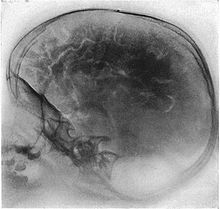Pneumoencephalography
The Pneumoenzephalografie or Pneumoencephalografie is a contrast-enhancing method, superficial structures of the brain in conventional radiographs as Pneumoenzephalogramm display. It was introduced in 1919 by the American neurosurgeon Walter Edward Dandy . At the time, this method was considered a milestone in diagnostics, but is now obsolete.
methodology
During pneumoencephalography, the cerebrospinal fluid is sucked off via a lumbar (see: lumbar puncture ) or suboccipital access and air is introduced to the same extent. By positioning the patient, it can now be achieved that the cerebral convolutions are very clearly visible against the air. For the first time, it was possible to show the convolutions of the brain radiographically in vivo with the skull closed, and in this way to clarify the suspicion of tumors , swellings or malformations in the case of neural abnormalities . Also encapsulated hematomas ( subdural as well as epidural) can be made visible.
Side effects
The puncture of the CSF space can cause hematomas, as well as devastating headaches, subarachnoid bleeding , seizures or even meningoencephalitis . Several deaths, particularly among children, have also been documented.
meaning
In its time, pneumoencephalography represented a milestone in diagnostics, as it was the first time that findings could be checked without having to open the skull (with the high-risk means at the time).
This examination method is now considered an obsolete technique, there is absolutely no indication any more, since slice imaging ( magnetic resonance tomography and computed tomography ) as well as ultrasound techniques for infants have a significantly lower or no secondary hazard potential.
literature
- Gergely Klinda: On the history of pneumoencephalography. Dissertation, Charité - Universitätsmedizin Berlin (2010), urn : nbn: de: kobv: 188-fudissthesis000000018730-6
Individual evidence
- ↑ Walter E. Dandy, MD. In: The Society of Neurological Surgeons. Retrieved April 20, 2016 .
- ↑ Gergely Klinda: Zur Geschichte der Pneumenzephalographie , p. 150 ff.
- ↑ See also Gerd Huber : Pneumencephalographic and psychopathological pictures in endogenous psychoses. Berlin 1957.
